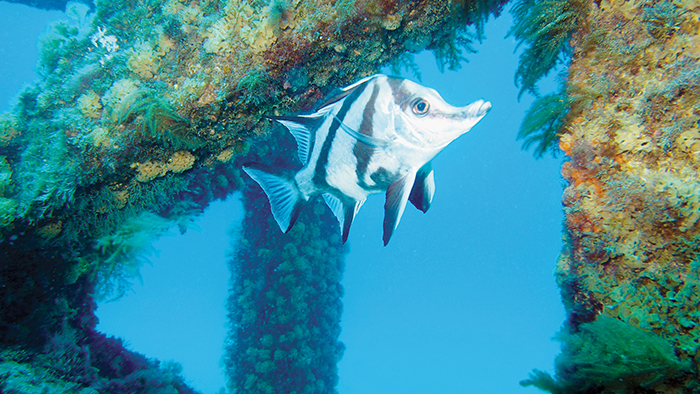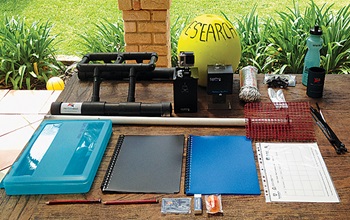Recreational fishers, motivated by community stewardship, are helping to develop cost-effective monitoring options for a Western Australian artificial reef trial
 The artificial reefs have attracted 50 finfish species, both large and small, such as the pictured Longsnout Boarfish.
The artificial reefs have attracted 50 finfish species, both large and small, such as the pictured Longsnout Boarfish. Photo: Lisa West, Department of Fisheries, WA
By Natasha Prokop
Baited remote underwater videos (BRUVs) have largely been the domain of scientists. However, the recreational fishing community in Western Australia is harnessing this technology for a unique citizen science program.
Reef Vision is part of an FRDC-funded research project investigating whether highly engaged recreational fishers can provide a cost-effective means of monitoring artificial reefs.
In south-west WA a network of 32 dedicated recreational anglers and supporting scientists is helping to monitor the social, biological and structural impacts of artificial reefs.
A key component of this program is an Australian first: the use of BRUVs by the general public as part of a coordinated monitoring program.
This program is based around the first-ever purpose-built artificial reefs in WA. Recfishwest chief executive officer Andrew Rowland is the principal investigator for the monitoring program, and says deployment of the new reefs was largely driven by WA’s 740,000 recreational fishers.
 Garry Dyer deploying his BRUV on the Dunsborough artificial reef.
Garry Dyer deploying his BRUV on the Dunsborough artificial reef. Photo: John Dyer
“These days fishers really understand that we take, take, take and that maybe it’s time to put something back, in the form of either habitat enhancement or artificial reefs,” he says.
In early 2013 the WA Department of Fisheries deployed the purpose-built reefs off the coast of two popular south-west towns: Bunbury (150 kilometres south of Perth) and Dunsborough (200 kilometres south of Perth).
The reefs consist of six clusters of five cube-shaped cement modules, each weighing 10 tonnes, spread across four hectares of seafloor. The custom design includes propeller-shaped cross braces to create upwellings that serve as the base for food webs, attracting higher-order fish.
Recreational fishing licence money provided 20 per cent of the $2.38 million price tag, with 80 per cent funded from the WA Government’s Royalties for Regions program.
The purpose: to provide a public amenity aimed at improving recreational fishing opportunities in the south-west of WA. The artificial reefs provide a safe fishing destination close to shore. This allows fishers with small boats to target species otherwise out of their reach.
New inhabitants
The reefs have quickly been colonised by a diverse range of species. The initial 12 species of fish observed pre-deployment, on a bare sand bottom, have been joined by more than 38 other species in the three years since deployment.
These include recreationally targeted species, which the reefs were designed to attract, such as Samsonfish (Seriola hippos), snapper (Pagrus auratus) and Silver Trevally (Pseudocaranx dentex). The reefs have also attracted smaller, non-target species in abundance, such as Rough Bullseye (Pempheris klunzingeri) and Western King Wrasse (Coris auricularis).
These diversity metrics are important. State legislation requires evidence that the objectives of the artificial reefs have been met and also that the reefs remain in position and are structurally sound.
Monitoring success
 Recfishwest provides the Reef Vision volunteers with an instruction kit, including their BRUV.
Recfishwest provides the Reef Vision volunteers with an instruction kit, including their BRUV. Photo: James Florisson
The ability to monitor these trial reefs is essential to help the making of additional artificial reefs in WA. The five-year program for the existing reefs included pre-deployment surveys and four years of monitoring by the Department of Fisheries, WA, at a cost of $575,000, funded by the WA Government.
Paul Lewis, a research scientist with the Department of Fisheries, WA, says future reef projects will not require the same high level of monitoring.
“However, because this is the first-ever trial of a purpose-built reef in WA, the scientific reference group overseeing the project wanted to get the most out of the monitoring, to best assess the reef and any impacts on the local environment,” he says.
This has included not only the trial reefs but also comprehensive surveys of local natural reefs, and other nearby artificial reefs, such as the HMAS Swan wreck and the Busselton Jetty.
Stereo BRUV technology is being combined with underwater stereo-video methods and side-scan sonar to best capture the size, biomass and diversity of fish present, and to assess the structural integrity and positioning of the reefs.
Andrew Rowland says the monitoring has offered a unique opportunity to run a citizen science program concurrently with an extensive and scientifically rigorous program. Reef Vision was born out of this opportunity.
Running the scientific and citizen programs concurrently will help determine whether the citizen-based program has the rigour and credibility needed to meet legislated monitoring requirements. If so, this could also help reduce the cost of future monitoring programs.
Reef Vision is being led by Recfishwest, which represents WA’s recreational anglers, with scientific oversight provided by Murdoch University and the Department of Fisheries, WA.
Fishers engaged
 Garry Dyer’s helpers, son Cooper and father John, on the way out to the Dunsborough artificial reef to drop their BRUV.
Garry Dyer’s helpers, son Cooper and father John, on the way out to the Dunsborough artificial reef to drop their BRUV. Photo: Garry Dyer
Andrew Rowland says this citizen science program differs from other community-based fisheries science projects, such as sending skeletons or reporting the presence of species, in terms of the level of commitment and engagement required.
“These artificial reef projects are what the community wants delivered on the back of its licence money,” he says. “So I think the sense of stewardship, and therefore the sense of wanting to contribute, is a lot higher than it would be perhaps for more generic fisheries-related science.”
Every two weeks, for more than seven months, local fishers have been dropping custom-built weighted skids with a GoPro® camera and bait basket attached (the BRUV) onto the artificial reefs.
They have been collecting biological data on the species inhabiting the reefs and their abundances. The year-round monitoring will also allow for the assessment of seasonal shifts in the fish communities that use the reefs.
This task requires not only the hour on the water waiting to retrieve the BRUV, but also time spent on preparation and travel to the boat ramp and reef.
Garry Dyer has been volunteering with the Reef Vision program for four months with the help of his father and young son. He says his passion for fishing and desire to give back to the community motivates him to keep going out each fortnight to deploy his BRUV.
“This was something that I could do to put back into the community,” he says. “The more the community can do to help out, the better it is for us as fishers and for the future of our fisheries.”
He says the community response to the reefs themselves and Reef Vision program has been strongly positive.
“When I’m at the boat ramp, people will see the BRUV in the boat and ask what it is. They’re really interested and supportive of it.”
Garry Dyer says one of his favourite elements of the program is sharing the experience with his family, friends and the rest of the fishing community.
“I make clips of the BRUV footage that I put on YouTube and send out to local tackle shops, to try and get the word out about what’s going on at the reefs and to help get the community behind it.”
The response from the community has extended to include local fishing businesses. Whitey’s Tackle in Australind and Dunsborough Outdoor Sportz have donated hundreds of dollars’ worth of merchandise as incentives for volunteers.
Andrew Rowland says the project is also investigating the capacity for other innovative technologies to be used as citizen science tools. One such tool is high-end fish-finding sonar, the structure scanning functions of which are capable of building 3D images of the underwater landscape.
“The community’s appetite to assist is definitely there,” Andrew Rowland says. “As these technologies continue to get more affordable and accessible, there’s no reason there can’t be some kind of transition more towards using these community-based methods.”
However, he says this project is not about replacing traditional, highly scientifically robust methods. Instead, the goal is to develop complementary methods that are cost-effective and which have the resolution to meet legislative requirements.
“It’s about partnerships,” Andrew Rowland says. “There’s the opportunity to do almost anything more cost-effectively with partnerships between scientific institutions and the community.”
Through such partnerships, and by harnessing the enthusiasm of recreational fishers such as Garry Dyer, these methods have the capacity to build community stewardship and provide cost-effective monitoring options, with potentially wide-ranging applications.
More information
Andrew Rowland, Recfishwest, 08 9246 3366,
andrew@recfishwest.org.au





